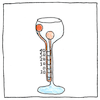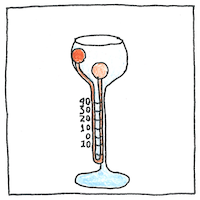John Leslie
thermometry

|
Aethrioscope
How cold is the sky? If you really want to know, you can make an aethrioscope. Put a differential thermometer in a parabolic metallic cup over a tall hollow pedestal. Screen one bulb from the sky and place the second bulb at the focus of the cup. When you expose the cup, the radiative effect contracts the air in the first bulb to pull the mercury up.
Radiative effect
Without the second law of thermodynamics, the radiative effect of a clear sky would seem like a special power. Euclid thought we see by light that emanates from our eyes. So the eyes of the evil Doctor Cold would bring misery to our intrepid hero if he were caught without a cover.
Clear
X-rays penetrate skin; radar cuts through fog or cloud; radio through windows and walls. Gravity seems like a force and a lens, water seems like a force and a lens, clear sky seems like a force and a lens.



The radiative effect would let a device like a aethrioscope, exposed to a clear night sky, act as a heat sink to help drive a Stirling engine.
See also in The book of science:
Readings in wikipedia: